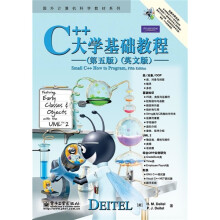Chapter1 Introduction to Computers, the Internet and World Wide Web
1.1 Introduction
1.2 What Is a Computer?
1.3 Computer Organization
1.4 Early Operating Systems
1.5 Personal, Distributed and Client/Server Computing
1.6 The Internet and the World Wide Web
1.7 Machine Languages, Assembly Languages and High-Level Languages
1.8 History of C and C++
1.9 C++ Standard Library
1.10 History of Java
1.11 FORTRAN, COBOL, Pascal and Ada
1.12 Basic, Visual Basic, Visual C++, C# and .NET
1.13 Key Software Trend: Object Technology
1.14 Typical C++ Development Environment
1.15 Notes About C++ and Small C++ How to Program, 5/e11
1.16 Test-Driving a C++ Application
1.17 Introduction to Object Technology and the UML
1.18 Wrap-Up
1.19 Web Resources
Chapter 2 Introduction to C++ Programming
2.1 Introduction
2.2 First Program in C++: Printing a Line of Text
2.3 Modifying Our First C++ Program
2.4 Another C++ Program: Adding Integers
2.5 Memory Concepts
2.6 Arithmetic
2.7 Decision Making: Equality and Relational Operators
2.8 Wrap-Up
Chapter 3 Introduction to Classes and Objects
3.1 Introduction
3.2 Classes, Objects, Member Functions and Data Members
3.3 Overview of the Chapter Examples
3.4 Defining a Class with a Member Function
3.5 Defining a Member Function with a Parameter
3.6 Data Members, set Functions and get Functions
3.7 Initializing Objects with Constructors
3.8 Placing a Class in a Separate File for Reusability
3.9 Separating Interface from Implementation
3.10 Validating Data with set Functions
3.11 Wrap-Up
Chapter 4 Control Statements: Part 1
4.1 Introduction
4.2 Algorithms
4.3 Pseudocode
4.4 Control Structures
4.5 if Selection Statement
4.6 if...else Double-Selection Statement
4.7 while Repetition Statement
4.8 Formulating Algorithms: Counter-Controlled Repetition
4.9 Formulating Algorithms: Sentinel-Controlled Repetition
4.10 Formulating Algorithms: Nested Control Statements
4.11 Assignment Operators
4.12 Increment and Decrement Operators
4.13 Wrap-Up
Chapter 5 Control Statements: Part 2
5.1 Introduction
5.2 Essentials of Counter-Controlled Repetition
5.3 for Repetition Statement
5.4 Examples Using the for Statement
5.5 do...while Repetition Statement
5.6 switch Multiple-Selection Statement
5.7 break and continue Statements
5.8 Logical Operators
5.9 Confusing Equality (==) and Assignment (=) Operators
5.10 Structured Programming Summary
5.11 Wrap-Up
Chapter 6 Functions and an Introduction to Recursion159
6.1 Introduction
6.2 Program Components in C++
6.3 Math Library Functions
6.4 Function Definitions with Multiple Parameters
6.5 Function Prototypes and Argument Coercion
6.6 C++ Standard Library Header Files
6.7 Case Study: Random Number Generation
6.8 Case Study: Game of Chance and Introducing enum
6.9 Storage Classes
6.10 Scope Rules
6.11 Function Call Stack and Activation Records
6.12 Functions with Empty Parameter Lists
6.13 Inline Functions
6.14 References and Reference Parameters
6.15 Default Arguments
6.16 Unary Scope Resolution Operator
6.17 Function Overloading
6.18 Function Templates
6.19 Recursion
6.20 Example Using Recursion: Fibonacci Series
6.21 Recursion vs. Iteration
6.22 Wrap-Up
Chapter 7 Arrays and Vectors 218
Chapter 8 Pointers and Pointer-Based Strings
Chapter 9 Classes: A Deeper Look, Part 1
Chapter 10 Classes: A Deeper Look, Part 2
Chapter 11 Operator Overloading; String and Array Objects
Chapter 12 Object-Oriented Programming: Inheritance
Chapter 13 Object-Oriented Programming: Polymorphism
Appendix A Operator Precedence and Associativity Chart
Appendix B ASCII Character Set
Appendix C Fundamental Types
Appendix D Number Systems
Appendix E C++ Internet and Web Resources
Appendix F Using the Visual Studio.NET Debugger
Appendix G Using the GNU C++ Debugger
Bibliography
Index

 缺书网
缺书网 扫码进群
扫码进群




